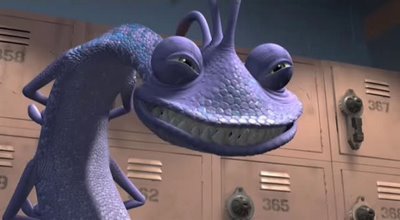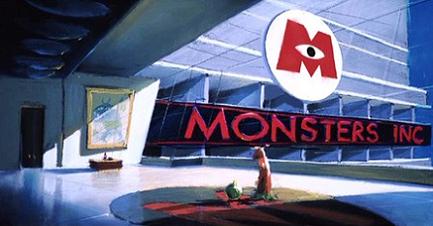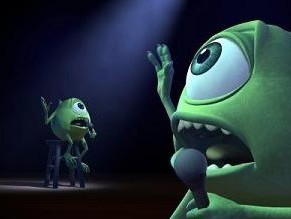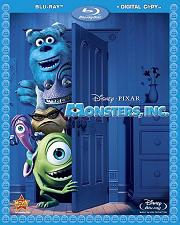From Toy Story to Cars, Randy Newman’s sound and style are part of Pixar’s genes.
Indeed, the success of their films is not based on mere special effects or any mocking at tradition. It’s more about tying an emotional link with the audience. They started out that with Toy Story, and the approach was still valid with Monsters, Inc., Pixar’s third feature hit.
Randy Newman’s score has the spirit, the humor and heart that fits the very special universe of Monstropolis – and that’s certainly because the man himself has it all! He scores because he cares!

Animated Views: Monsters, Inc. was your fourth collaboration with Pixar after Toy Story, Bug’s Life and Toy Story 2. How did you find going back again?
Randy Newman: It’s been a very good collaboration. They’re good people to work for. They made four good pictures in a row which is a real thing! I had to write music for Monsters, Inc. which I never would have written on my own. It kind of stretches you out, and it’s been good for my technique, the counterpoint, the harmony. It’s certainly the best score I had done. It’s very different, very much 20th century, and far more elaborate than what I did as a songwriter and I am proud of the job I did. It proved me that I could do those very difficult jobs. I’m grateful that was a part of it, doing things that are that different.

AV: How did you work with Pete Docter, who is a very musically knowledgeable person, too?
RN: We worked face to face! Lasseter was also involved. He was a first-time director but he had definite opinions about things. If I disagreed, I’d tell him I did. Sometimes, I would prevail, and most of the time, the director prevailed. Basically, with the director you have a boss and you try and satisfy the boss.
AV: The core of the movie is the Mike and Sully’s friendship. How did you approach these characters?
RN: Like Woody and Buzz, they’re friends, but they’re different. So, the themes may be a little corkier. For them, I tried to use some unusual instruments like bass harmonica and bass accordion and a little bit of jazz. The song reflects their friendship essentially. It’s just another scuffle that I seem to can’t help writing.

AV: But everything changes with Boo!
RN: At first, I had played her as if she were a monster because that’s how they perceived her. In each of these Pixar pictures, I’ve taken the emotions of the characters seriously. In every picture, they’re adults, they’re not children. The film is for children primarily, in a way, but the characters have adult emotions. They felt about her as if she were something like an alien. So, I wrote some dissonant kind of frightening music for her. And yet, you’re meant to laugh. But still, I wanted it full of terror, you know. Then, for the other theme, I played her just as a little girl going to sleep. There’s one scene when Sully begins to feel something for her as she finally goes to sleep in his bed: then she begins to appear differently to him.

AV: Your score for the Scare Floor sequence is pretty amazing. Can you tell me about it?
RN: The people at Pixar liked that 1940s jazz. I did it in Bug’s Life and they loved it when I did Flick going to the City and stuff like that. So, it was essentially what they wanted. I’m not sure what I would have done, entirely left on my own. It might have been more sort of mechanical, like French composer Arthur Honegger’s 1930s factory stuff. But that’s what they wanted and it worked out very well.

AV: Another great influence of yours is Nino Rota, noticeable in your treatment for Randall.
RN: Thank you for noticing it. I love his music. I love those Italian band kind of sounds. And also I can do evil with that theme as it is written in minor and orchestrated with a trombone solo and some saxes. So, it resembles Rota’s music in some of its incarnations.
AV: Your approach to animation seems to largely appeal to Mickey Mousing as your score really sticks to the picture.
RN: Yes. I think, if you don’t do that in an animated picture, they don’t look right. I don’t think you could score one and have it be effective if you don’t notice when the characters are engaged in an animated kind of behavior: falling down, running, etc. In a normal movie with Billy Crystal running down a hallway from a bad guy, you’ll necessarily play it with sixteenth notes. But they don’t do that in these kinds of movies and they don’t look right to me. As a matter of fact, in action movies, because composers don’t have time, a lot of times, they’ll play big, long notes. But I don’t think anyone notices that anymore. In a picture like Gladiator, at times I thought that they could have moved along a little more than they did. I’m sure it’s a good score but, in the battle scenes, a little braver stuff might have helped it a little. When Mike and Sully are running the hallway from Waternoose, I want to be running with them!

AV: Having worked on so many CG animated features and now working on a hand-drawn one [Disney’s The Princess And The Frog], do you see any difference in your approach of both mediums?
RN: The look of films like Monsters, Inc. is so complex and deep that it needed a big orchestra. And also, I think they wanted to warm it up a bit. Particularly with Toy Story where the technology was not like what it is now. Specifically, they did not want synthesizers doing anything. But essentially, I think it was like regular animation. James and the Giant Peach was a little more lyrical. You didn’t have people running around and jumping and falling and being in danger. It was in general a quieter kind of piece. That said, these are all action pictures and I know that sometimes you can play against action – they did it in Dance with Wolves. But I don’t think they can do it that much nowadays. I think it hurts it.
AV: The richness of your orchestrations responds to the visual richness of the movie. Can you tell me about that aspect of your compositions?
RN: Orchestration is very important to me. I write sketches, twelve lines [far more than what is usually done – JN] and make them as detailed as I can. Then, I give them to my orchestrators and they usually just put them on orchestration paper. If they think of something that might be better – maybe like a trombone to double the cello – they suggest it and most often we do that. Because orchestrators like Jonathan Sacks really know the orchestra. He was of big help to me on Monsters, Inc.

It’s a strange thing: during the 20th century, orchestration never got much fancier than Ravel in a way. It wasn’t what people were interested in. They were interested in twelve-tone music or John Adams’ sequential stuff. Stravinsky’s Rite dates back to 1913 and none went much further. I’m very interested in that kind of questions, maybe because of my family, I don’t know why. But if I were writing just four lines and letting somebody orchestrate it, I wouldn’t do movie, because it’s the orchestra that interests me.
AV: You seem to want to push the orchestra to its limits, like when you call upon very high notes.
RN: There are instruments that you can push and instruments that you can’t push – for example, the oboe sounds terrible up there! But I like to extend their ranges. I also like piccolo down low. Like I say, it’s a field that interests me, so I try stuff. And not much else interests me.
AV: How do all these orchestrations come to you?
RN: I react entirely to what I see up there on the screen. Sully is a solid kind of…not quite a straight man but a hero, no doubt about it. But a common man hero. I love this scene with those fans of his when they go to the factory! I was very fond of those guys!

AV: The number, the style and the role of songs in Pixar films is very different from Disney’s animated musicals. What’s your take on that?
RN: I don’t like the harmonic vocabulary of Broadway. I don’t understand where it comes from. It’s like bad Puccini to me. The harmonic vocabulary I use in the songs is my own. They’re more sort of pop or… hard to say. They sound like me to me. Strange Things is rock’n’roll basically, and the ballad I Will Go Sailin’ No More is not Broadway because I’m not familiar in that. Speaking of the role of the songs, only in the first Toy Story did I use the song to tell the story. But it was interior. They didn’t want any of the characters to sing.
In James and the Giant Peach, I did write things that the characters sang so that the story was carried forward with the music. In the Pixar films, the songs tell you what is in the minds of the characters, in Buzz’s mind in Strange Things or in Jessie’s mind in the Sarah McLachlan song. So, it’s different in that sense. What was required from Pixar was not story but emotions and internalizing, what the characters are feeling. And on Monsters, Inc., they just wanted a song about Mike and Sully.

AV: But friendship is not the only subject of the movie.
RN: Of course. It’s: appearances are not indicative of persons’ worth and personality. And I think what was big to them, too was that overcoming of fear. Fear is kind of a paralyzing thing that can be dissipated by knowledge. Music is in there, I guess, in that it can’t give you much information but it is best at emotional things, at enhancing excitement, enhancing a tender moment.
Music is a philosophical medium…
With all our gratitude and appreciation to Randy Newman.








